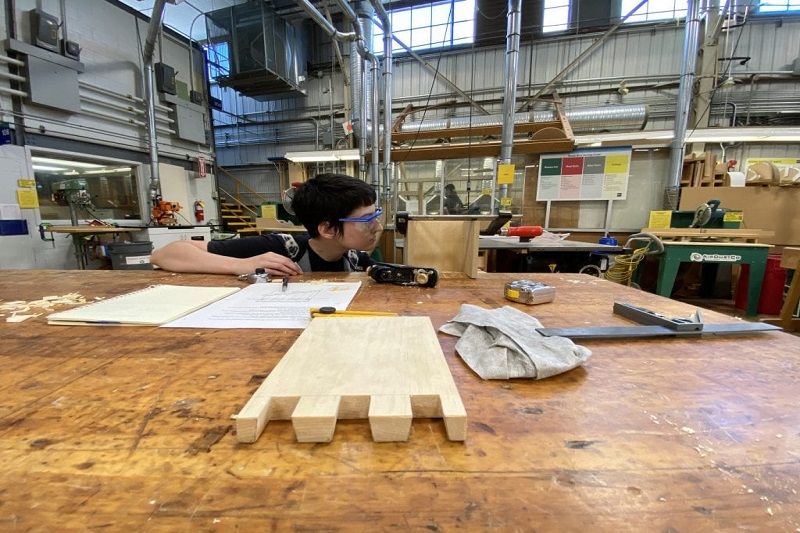As a woodworker, one of the most important decisions you will make is choosing the right joinery technique for your project. Joinery is the method by which two pieces of wood are connected, and the right joint can make all the difference in the quality, strength, and longevity of your work. With so many joinery options available, it can be overwhelming to know which technique to use for your specific project. In this article, we will discuss different joinery techniques, their strengths, and weaknesses.

How to choose the right one for your woodworking project.
Mortise and Tenon
Mortise and tenon joinery is one of the oldest and most widely used methods in woodworking, known for its strength and durability. A mortise is a cavity cut into one piece of wood, while a tenon is a protrusion on the end of another piece that fits snugly into the mortise. This joint is often reinforced with glue or a wooden peg for added strength.
Strengths:
- Very strong and durable
- Can be used in a variety of applications.
- Can be reinforced with glue or pegs.
Weaknesses:
- Requires precise measuring and cutting.
- Can be time-consuming to create.
Dovetail
The dovetail joint is another classic joinery Bayswater technique, known for its resistance to pulling apart and its beautiful appearance. This joint consists of a series of interlocking wedge-shaped “tails” and “pins” that fit together tightly, creating a strong bond. Dovetail joints are often found in high-quality furniture and cabinetry.
Strengths:
- Resistant to pulling apart
- Attractive appearance
- Can be used in a variety of applications
Weaknesses:
- Requires precise measuring and cutting
- Can be time-consuming to create
Dowel
Dowel joinery involves using cylindrical wooden rods (dowels) to connect two pieces of wood. Holes are drilled into both pieces, and the dowel is inserted with glue to hold the joint together. Dowel joints are often used in furniture construction, particularly for connecting legs to tabletops or rails to stiles.
Strengths:
- Strong and durable
- Can be used in a variety of applications
- Relatively easy to create
Weaknesses:
- Requires precise measuring and drilling
- May not be as attractive as other joinery methods
Biscuit
Biscuit joinery utilizes small, oval-shaped wooden “biscuits” to connect two pieces of wood. Slots are cut into both pieces, and the biscuit is inserted with glue to hold the joint together. This method is often used in furniture and cabinetry construction, particularly for joining panels or edges.
Strengths:
- Strong and durable
- Can be used in a variety of applications
- Relatively easy to create
Weaknesses:
- Requires a specialized tool (biscuit joiner)
- May not be as attractive as other joinery methods
Pocket Hole
Pocket hole joinery involves drilling an angled hole into one piece of wood and driving a screw through the hole to connect it to another piece of wood. This technique is often used in furniture and cabinetry construction, particularly for connecting face frames to carcasses or rails to stiles.
Strengths:
- Strong and durable
- Can be used in a variety of applications
- Relatively easy to create
Weaknesses:
- Requires a specialized tool (pocket hole jig)
- Visible screw holes may be less attractive than other joinery methods
Finger Joint
Finger joints, also known as box joints, consist of a series of interlocking square “fingers” that fit together tightly, creating a strong bond. This joint is often used in box construction and other applications where strength is needed but appearance is not a priority.
Strengths:
- Strong and durable
- Can be used in a variety of applications
Weaknesses:
- Requires precise measuring and cutting
- Less attractive than other joinery methods

Miter
A miter joint is created by cutting the ends of two pieces of wood at a 45-degree angle and joining them together to form a 90-degree angle. This joint is often used in picture frame construction and other applications where appearance is a priority.
Strengths:
- Attractive appearance
- Can be used in a variety of applications
Weaknesses:
- Not as strong as other joinery methods
- Requires precise measuring and cutting
Lap Joint
Lap joints involve removing a portion of one piece of wood and overlapping it with another piece of wood, creating a strong bond. This joint is often used in furniture and cabinetry construction, particularly for connecting rails to stiles or face frames to carcasses.
Strengths:
- Strong and durable
- Can be used in a variety of applications
Weaknesses:
- Requires precise measuring and cutting
- May not be as attractive as other joinery methods
Choosing the Right Joinery Technique
When choosing the right joinery technique for your woodworking project, consider the following factors:
- Strength: Consider the required strength of the joint, based on the type of project and its intended use. Mortise and tenon, dovetail, and dowel joints are among the strongest options.
- Appearance: If the appearance of the joint is a priority, consider techniques such as dovetail or miter joints, which are known for their attractive appearance.
- Skill Level: Some joinery techniques, such as mortise and tenon or dovetail joints, require more skill and precision than others. Choose a technique that matches your skill level and comfort with woodworking tools.
- Tools: Some joinery techniques, such as biscuit or pocket hole joinery, require specialized tools. Ensure you have the necessary tools before choosing a technique.
Conclusion
In conclusion, choosing the right joinery technique for your woodworking project is essential for creating strong, durable, and attractive connections between pieces of wood. By considering factors such as strength, appearance, skill level, and available tools, you can select the best joinery method for your specific project. With practice and experience, you will become more proficient at creating a variety of wood joints, ultimately improving the quality and longevity of your woodworking creations.
